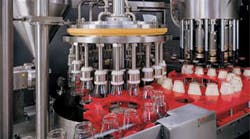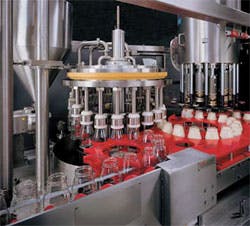Many equipment manufacturers consider pneumatic components — such as valves, motors, filters, and regulators — to be commodity items, focusing product selection on price and availability rather than other characteristics. This nonchalant outlook changes however, when an OEM must decide on components for food processing equipment. Food processing equipment must remain clean and achieve long life despite frequent wash down with aggressive solutions.
Material selection comes first
Caustic sprays in wash down cycles in food processing involve hydrogen peroxide and other cleaning agents that eat away at aluminum, brass, and zinc materials not safely secured in a protective enclosure. Constant exposure to damp and aggressive environments can cause pitting and weaken many metals. If a component made of carbon steel or aluminum is used in these instances, the initial cost may be low, but it will be a poor investment. Coatings will peel off, contamination will occur, and poor performance will result.
Stainless steel, therefore, is the material of choice for these applications. Stainless steel is more expensive than aluminum and is more costly to machine, but it meets stringent requirements for hygiene and corrosion resistance. So it is well worth the higher initial investment.
Several factors should be considered including performance, international corrosion resistance standards, external design, and ease of maintenance. NACE International (originally National Association of Corrosion engineers) sets corrosion standards for industries, including food processing, oil, gas, petrochemical, highways, telecommunications, and home appliances.
Judging performance
Begin the selection process by understanding the details of a corrosive application and what is required, such as pressure, temperature, flow, and port sizes, configurations, and locations. This may seem obvious, but a filter or valve is often chosen based on cost or size alone, and a manufacturer may spend hours performing on-going maintenance resulting from a poor selection. Longevity and repeatability are basic requirements for a good pneumatic solution. Choose components that have been thoroughly tested and designed to withstand the toughest conditions for operation, vibration, and impact.
You should also consider temperature requirements. In applications where temperatures may fall well below freezing, many manufacturers offer products, such as a filter-regulators, specifically designed to withstand these conditions without sacrificing performance or reliability. In a filter-regulator, for example, air must be dry enough to avoid ice formation. If temperatures reach 32 F or lower, performance will be degraded because liquid particles become gelatinous or frozen.
Choosing the right options
Accessories and options for pneumatic components are often overlooked. Ensure that the entire product is able to withstand the environment in which it will operate. Otherwise, money will be wasted replacing parts and dealing with inferior performance. For example, typical regulators have a composite adjustment knob or T-handle. The caustic chemicals used in wash down affect the entire pneumatic component and will corrode many types of plastic, so in addition to a stainless steel regulator, the knob should also made of stainless steel or other compatible material.
Look for options on filter-regulators — such as a tapped manual drain or an automatic stainless steel drain — that require little maintenance and are widely used in food applications to direct excess liquid away and prevent water from draining onto the floor. Non-relieving regulators that do not release gases or liquid into the atmosphere can be critical to clean room environments. If the application allows, select pre-lubricated or lubrication-free mechanisms that use food-grade grease and do not require periodic lubrication.
The OEM decided to replace the old valves and install a pre-assembled and thoroughly tested all-in-one manifold that meets ISO requirements. The manifold uses pressure sensors and serial communications to alert machine operators immediately if a tank is open or closed during batching operations.
Choosing quick connectivity serial communication modules and using sensor feedback to confirm valve shifts completely eliminated injection failure and the cost of cleanup and disposal that resulted — more than $37,000 each instance.
External design, maintenance
Manufacturers of food processing equipment should select components designed specifically to meet food processing environments. For example, a convex shape makes air cylinders easy to keep clean. The cylindrical design eliminates pockets that tend to accumulate dirt or bacteria. A positive external seal between halves of the body reduces potential dirt traps.
Although many pneumatic valves meet NEMA standards or IEC/IP ratings, most are mounted in an enclosure to protect them from wash down. Be sure to check the design of this enclosure. The crevices between the valves and subplate or manifold bases and other non-smooth surfaces can harbor bacteria. For OEMs that use serial communications with their valves, electronics also need to be protected from the elements.
You should also specify valves and cylinders that offer pre-lubed or lubrication-free operation. Lubrication-free means that no particles of lubricant will escape with exhaust air, which reduces overall service costs. Having a component pre-lubed simplifies setup because it is not necessary to apply lubrication externally to the system. Lubricant in the compressed air can collect on surfaces near exhaust ports, and manually applied lubricant can spill onto or collect on multiple components. Therefore, components requiring lubricated compressed air or periodic manual lubrication should be avoided when working in food processing.
It is also critical to use dry air in non-lubricated applications because condensed water can corrode system components, resulting in increased maintenance costs and reduced system efficiency. Furthermore, unless distribution air lines are made of stainless steel, aluminum, or high-strength plastic, water can create pipe scale that could work its way into components and cause malfunctions. Water is a poor lubricant, and when mixed with residual compressor oils, it becomes emulsified, resulting in a milky substance that must be drained away. Depending on the amount of liquid, this can become an issue with OSHA. In addition, synthetic emulsions should not come into contact with anything in food processing applications. With dry, filtered, non-lubricated air, these issues are usually eliminated.
Picking the optimal design
Choosing the right components helped another food processing OEM that was fabricating a new line of filling machines for extremely high-speed production. Designers wanted to achieve higher performance with a smaller shop floor footprint.
A redesign of the pneumatic valve system in its machinery using collective wiring and stainless steel filter-regulators reduced the overall footprint by nearly half and decreased build and installation time. In this case, choosing the right components and using a knowledgeable supplier who understood their overall processes resulted in:
• reduced control panel size by 50%
• decreased component prices by $1000 per machine
• one-hr less required wiring time per machine
• one-hr less required plumbing time per machine
• $2200 operating cost savings per machine ($22,000 per year).
Summary
Although choosing a pneumatic component for any industrial machinery often comes down to price, you will save future frustration and ensure optimal performance for equipment that operates in corrosive environments if you examine competitive options. Consider your application and be sure to choose a vendor that can understand your process and has a history of reliability. Inferior parts can be costly to your quality, performance, and maintenance costs.
Michael Nick is product sales manager at Parker Hannifin Corp., Pneumatics Div. Contact him at [email protected] or (269) 629-2576 or visit http://www.parker.com/pneumatics.



